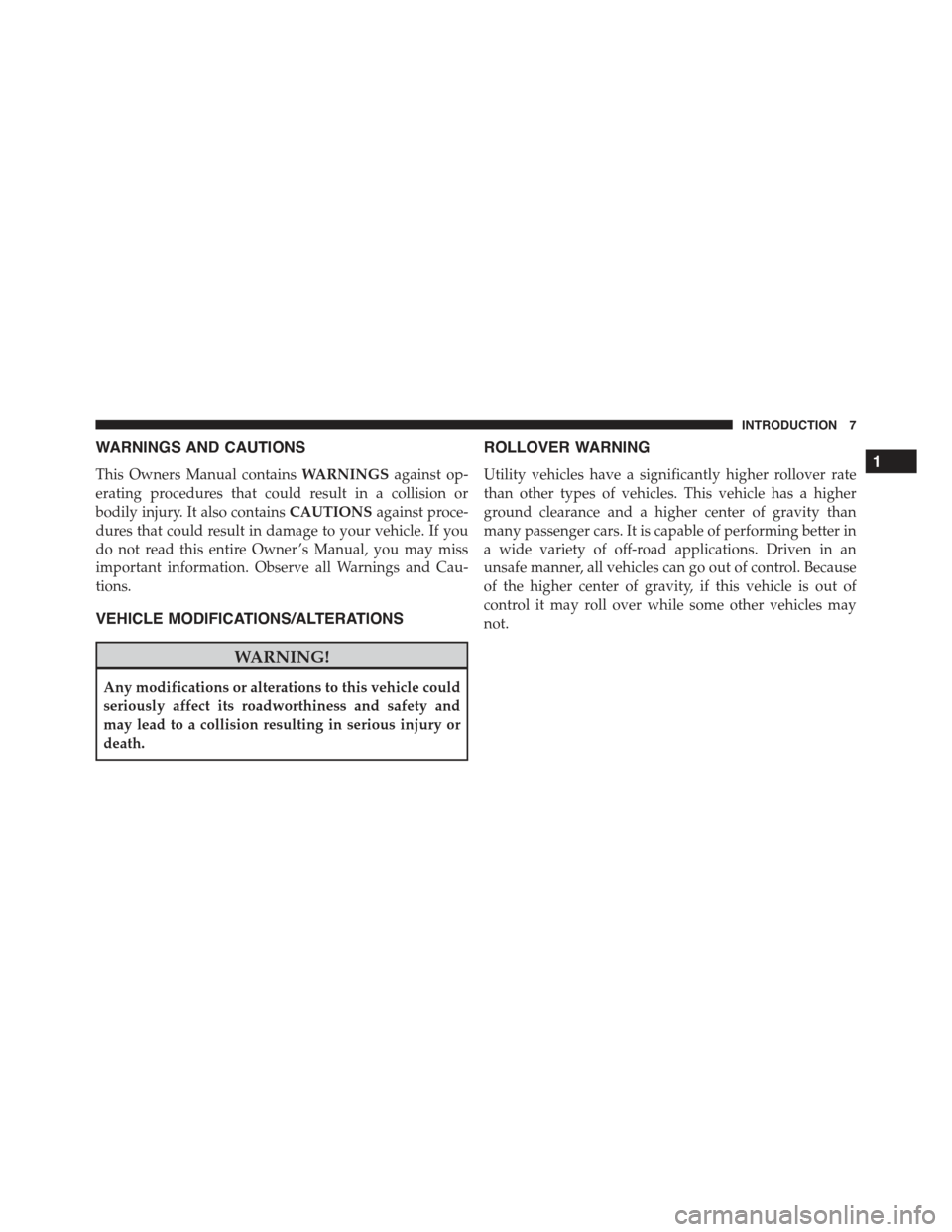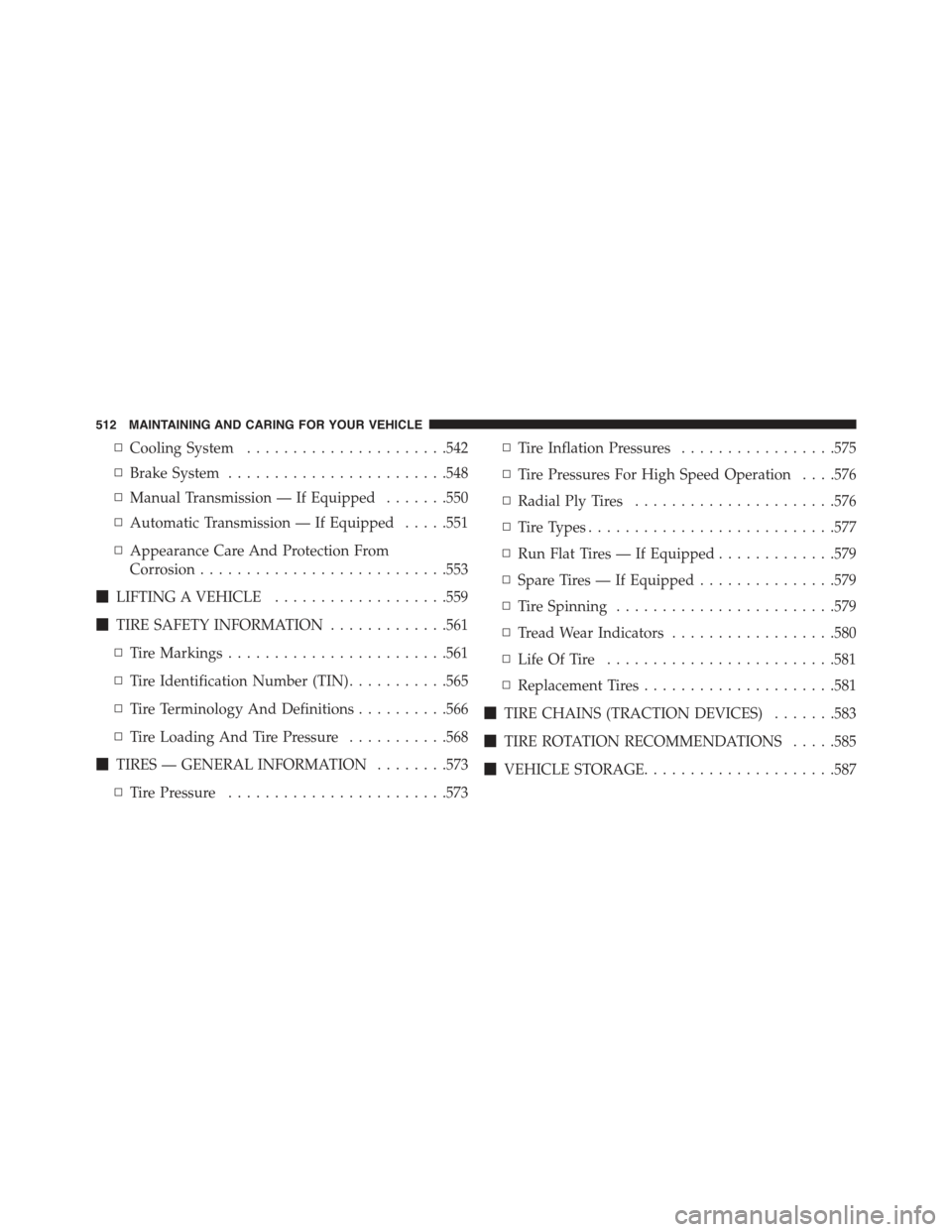Page 9 of 678

WARNINGS AND CAUTIONS
This Owners Manual containsWARNINGSagainst op-
erating procedures that could result in a collision or
bodily injury. It also containsCAUTIONSagainst proce-
dures that could result in damage to your vehicle. If you
do not read this entire Owner ’s Manual, you may miss
important information. Observe all Warnings and Cau-
tions.
VEHICLE MODIFICATIONS/ALTERATIONS
WARNING!
Any modifications or alterations to this vehicle could
seriously affect its roadworthiness and safety and
may lead to a collision resulting in serious injury or
death.
ROLLOVER WARNING
Utility vehicles have a significantly higher rollover rate
than other types of vehicles. This vehicle has a higher
ground clearance and a higher center of gravity than
many passenger cars. It is capable of performing better in
a wide variety of off-road applications. Driven in an
unsafe manner, all vehicles can go out of control. Because
of the higher center of gravity, if this vehicle is out of
control it may roll over while some other vehicles may
not.
1
INTRODUCTION 7
Page 185 of 678

WARNING!
A hot engine cooling system is dangerous. You or
others could be badly burned by steam or boiling
coolant. You may want to call an authorized dealer
for service if your vehicle overheats. If you decide to
look under the hood yourself, see “Maintaining And
Caring For Your Vehicle.” Follow the warnings under
the “Cooling System Pressure Cap” paragraph.
WARNING LIGHTS AND MESSAGES
The EVIC/DID display consists of three sections:
1. The reconfigurable top line where compass, direction,
and outside temperature are displayed.
•Right side default to Ignition Status for those with
push button ignition.
2. The main display area where the menus and pop up
messages are displayed.
3. The reconfigurable telltales section.
The main display area will normally display the main
menu or the screens of a selected feature of the main
menu. The main display area also displays#pop up#
messages that consist of approximately 60 possible warn-
ing or information messages. These pop up messages fall
into several categories:
•Five Second Stored Messages
When the appropriate conditions occur, this type of
message takes control of the main display area for five
seconds and then returns to the previous screen. Most of
the messages of this type are then stored (as long as the
condition that activated it remains active) and can be
reviewed from the#Messages#main menu item. As long
as there is a stored message, an#i#will be displayed in the
EVIC’s compass/outside temp line. Examples of this
message type are#Right Front Turn Signal Lamp Out#
and#Low Tire Pressure.#
5
GETTING TO KNOW YOUR INSTRUMENT PANEL 183
Page 192 of 678

CAUTION!(Continued)
equipped on your vehicle. Undesirable system opera-
tion or sensor damage may result when using re-
placement equipment that is not of the same size,
type, and/or style. Aftermarket wheels can cause
sensor damage. Using aftermarket tire sealants may
cause the Tire Pressure Monitoring System (TPMS)
sensor to become inoperable. After using an after-
market tire sealant it is recommended that you take
your vehicle to an authorized dealership to have your
sensor function checked.
•What To Do
Do not drive your vehicle with one or more tires
deflated because the driveability of the car could be
compromised. Stop the car and avoid braking and
sharp turns. Contact your authorized dealer as soon
as possible.
ESC System
•What Does It Mean
Intervention ESC System:The light will
start to flash as soon as the tires lose
traction and the ESC system becomes ac-
tive. If the “ESC Activation/Malfunction Indicator
Light” begins to flash during acceleration, ease up on
the accelerator and apply as little throttle as possible.
Be sure to adapt your speed and driving to the
prevailing road conditions.
Failure ESC System:If the light remains perma-
nently on after four second of the engine running,
there may be a failure in ESC system.
190 GETTING TO KNOW YOUR INSTRUMENT PANEL
Page 227 of 678

WARNING!(Continued)
hydroplaning. ESC also cannot prevent collisions
resulting from loss of vehicle control due to inappro-
priate driver input for the conditions. Only a safe,
attentive, and skillful driver can prevent collisions.
The capabilities of an ESC equipped vehicle must
never be exploited in a reckless or dangerous manner
which could jeopardize the user ’s safety or the safety
of others.
Anti-Lock Brake System (ABS)
The Anti-Lock Brake System (ABS) is designed to aid the
driver in maintaining vehicle control under adverse
braking conditions. The system operates with a separate
computer to modulate hydraulic pressure, to prevent
wheel lock-up and help avoid skidding on slippery
surfaces.
All vehicle wheels and tires must be the same size and
type, and tires must be properly inflated, to produce
accurate signals for the computer.
WARNING!
Significant over or under-inflation of tires or mixing
sizes of tires or wheels on the vehicle can lead to loss
of braking effectiveness.
The ABS conducts a low-speed self-test at approximately
12 mph (20 km/h). If you have your foot lightly on the
brake while this test is occurring, you may feel slight
pedal movement. The movement can be more apparent
on ice and snow. This is normal.
The ABS pump motor runs during the self-test at 12 mph
(20 km/h) and during an ABS stop. The pump motor
makes a low humming noise during operation, which is
normal.
6
SAFETY 225
Page 356 of 678
CAUTION!
All wheels must have the same size and type tires.
Unequal tire sizes must not be used. Unequal tire
size may cause failure of the power transfer unit.
Four Wheel Drive (4X4)
The four wheel drive (4WD) is fully automatic in normal
driving mode.
NOTE:It is not possible to carry out the change of mode
when the car exceeds the speed of 75 mph (120 km/h).
Enabling Four Wheel Drive (4x4)
The buttons for the activation of four wheel drive are
located on the device Selec-Terrain™ and allow you to
select the following:
•4WD LOCK
•4WD LOW — (Trailhawk models only)
354 STARTING AND OPERATING
Page 382 of 678

CAUTION!
•The TPMS has been optimized for the original
equipment tires and wheels. TPMS pressures and
warning have been established for the tire size
equipped on your vehicle. Undesirable system op-
eration or sensor damage may result when using
replacement equipment that is not of the same size,
type, and/or style. Aftermarket wheels can cause
sensor damage. Using aftermarket tire sealants may
cause the Tire Pressure Monitoring System (TPMS)
sensor to become inoperable. After using an after-
market tire sealant it is recommended that you take
your vehicle to an authorized dealership to have
your sensor function checked.
(Continued)
CAUTION!(Continued)
•After inspecting or adjusting the tire pressure,
always reinstall the valve stem cap. This will
prevent moisture and dirt from entering the valve
stem, which could damage the Tire Pressure Moni-
toring Sensor.
NOTE:
•The TPMS is not intended to replace normal tire care
and maintenance, or to provide warning of a tire
failure or condition.
•The TPMS should not be used as a tire pressure gauge
while adjusting your tire pressure.
380 STARTING AND OPERATING
Page 416 of 678
Never exceed the maximum tongue weight stamped on
your bumper or trailer hitch.
Consider the following items when computing the
weight on the rear axle of the vehicle:
•The tongue weight of the trailer.
•The weight of any other type of cargo or equipment
put in or on your vehicle.
•The weight of the driver and all passengers.
NOTE:Remember that everything put into or on the
trailer adds to the load on your vehicle. Also, additional
factory-installed options or dealer-installed options must
be considered as part of the total load on your vehicle.
Refer to the “Tire and Loading Information” placard for
the maximum combined weight of occupants and cargo
for your vehicle.
414 STARTING AND OPERATING
Page 514 of 678

▫Cooling System......................542
▫Brake System........................548
▫Manual Transmission — If Equipped.......550
▫Automatic Transmission — If Equipped.....551
▫Appearance Care And Protection From
Corrosion...........................553
!LIFTING A VEHICLE...................559
!TIRE SAFETY INFORMATION.............561
▫Tire Markings........................561
▫Tire Identification Number (TIN)...........565
▫Tire Terminology And Definitions..........566
▫Tire Loading And Tire Pressure...........568
!TIRES — GENERAL INFORMATION........573
▫Tire Pressure........................573
▫Tire Inflation Pressures.................575
▫Tire Pressures For High Speed Operation . . . .576
▫Radial Ply Tires......................576
▫Tire Types...........................577
▫Run Flat Tires — If Equipped.............579
▫Spare Tires — If Equipped...............579
▫Tire Spinning........................579
▫Tread Wear Indicators..................580
▫Life Of Tire.........................581
▫Replacement Tires.....................581
!TIRE CHAINS (TRACTION DEVICES).......583
!TIRE ROTATION RECOMMENDATIONS.....585
!VEHICLE STORAGE.....................587
512 MAINTAINING AND CARING FOR YOUR VEHICLE